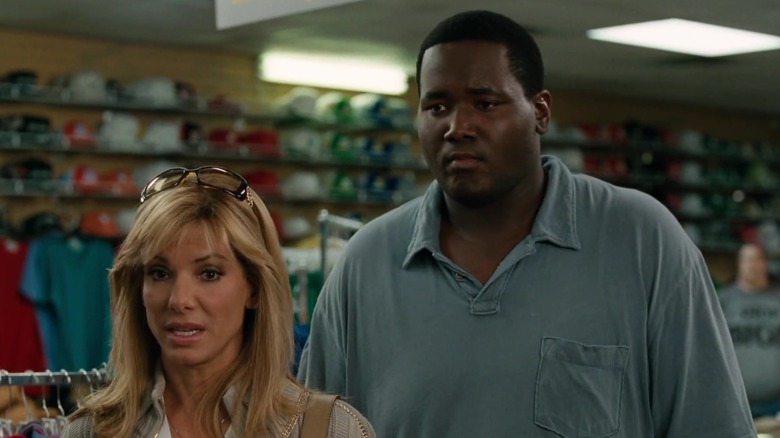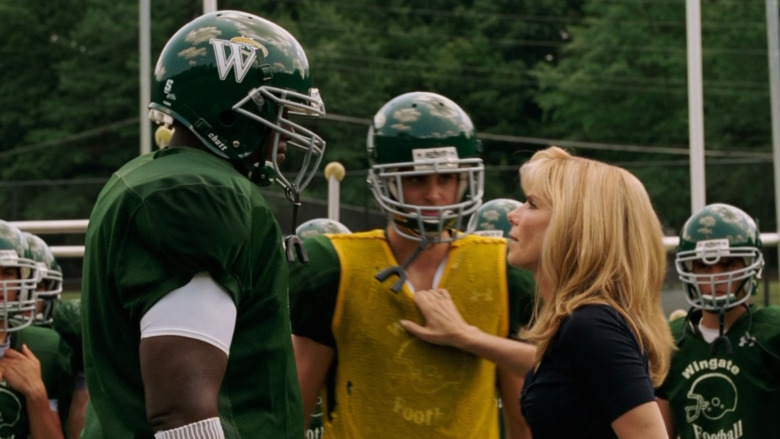What The Blind Side Doesn't Tell You About The True Story
People who don't know a left tackle from a right guard or pass interference from holding can still appreciate movies about football. (Not to mention sports video games you'll probably enjoy even if you don't like sports.) Movie magic can turn every touchdown and tackle into a dramatically fraught situation. But often, it's the lives of the players off the field that grab you by the heartstrings. After all, when sports can provide a potential lifeline out of poverty, winning and losing isn't just a game, it's a matter of life and death.
One of the most successful movies to explore the transformational power of sports is "The Blind Side." The film quickly went on to become the ninth highest-grossing movie in the U.S. in 2009, and earned Sandra Bullock a best actress Oscar. Bullock played Leigh Anne Tuohy opposite Quinton Aaron who portrayed Michael Oher. When the movie came out, Oher was in his first season in the NFL with the Baltimore Ravens — though he eventually won a Super Bowl with the team in 2013 (via EW). But "The Blind Side" showcased his childhood growing up in poverty without parental support or a stable home. Soon enough, that all changed after Leigh Anne and her family adopted Oher and helped him get to college, and then to the NFL.
Squeezing the first 18 years of a person's life into a two-hour, biographical movie is pretty difficult. ("Boyhood" might be the exception that proves this rule, and it's one of those movies that took forever to make.) Given how much Oher had lived through by the time he reached high school, it's disappointing but perhaps not surprising that "The Blind Side" oversimplifies his journey. This is the true story of Michael Oher, and what he thinks of the movie about his early life.
The Blind Side movie oversimplifies Michael Oher's journey
"The Blind Side" gives the bulk of the credit for Oher's rise from poverty to football star to the Tuohys. And, of course, to Oher's athletic abilities, football instincts, and determined personality, which were real. But it took many people from different parts of Oher's life to provide the support and opportunities he needed to achieve athletic stardom.
In his book "I Beat the Odds: From Homelessness to the Blind Side and Beyond," Oher credits some of his 11 siblings with protecting him when he was a child (he was his mother's sixth child). He also says that even though he and his siblings feared social workers because they didn't want to be separated, he now appreciates that his case worker did their best to not let him slip through the cracks. Although some of his foster homes were "less than ideal," as Oher put it in the book, some provided at least a measure of security. However, he would still try to run away to find his mom.
The movie does show that before Oher met the Tuohys, he was staying with an athletic coach from his public housing complex in Hurt Village — Tony Henderson (Hamilton in the movie) — who helped Oher get into a private high school. In real life, it was Briarcrest Christian School, not Wingate.
To be fair to "The Blind Side," most of the movie takes place after Oher has entered Wingate. But that focus still pulls attention away from the other people in his life who did try to help him, including his own family and people from his community.
Michael Oher already knew how to play football
Michael Oher has one main issue with the Hollywoodized version of his life. Namely, it's the film's implication that he's unintelligent, rather than "a kid who had never had consistent academic instruction and ended up thriving once he got it," he wrote in "I Beat the Odds." Above all, Oher pointed out that, unlike in the movie, he was already playing and studying football (and multiple other sports) when he met and moved in with the Tuohys.
In "The Blind Side," Oher meets the Tuohys shortly after getting into Wingate, through a friendship with their young son S.J. (Jae Head). It takes a condiment-oriented demonstration from S.J. and Leigh Anne Tuohy interrupting practice with a family-based metaphor for Oher to figure out blocking. In reality, by the time Oher and the Tuohys connected, he was already running track and playing basketball — the sport he originally thought he'd go pro at — as well as football. The two parties met at various athletic events, and it was the Tuohy patriarch, Sean, who noticed Oher was couch-surfing without a stable home. Sean started paying for Oher's school meals and then offered him a place to stay for one or two days at a time. Oher was invited to Thanksgiving, and finally, Leigh Anne asked him to stay permanently.
According to Oher, the greatest help that the Tuohys offered him didn't come in the form of football tutorials (again, he already knew how to play the sport when he met Leigh Anne and Sean), but their ability to take care of his most basic needs.
The Blind Side didn't need to rewrite Oher's football education
While speaking with People Magazine in 2021, Michael Oher talked heavily about the positive impact that being taken in by the Tuohys had on him. In specific, Oher said that it was the stability that the Tuohys provided for him that allowed him to thrive and grow into the person he's become. "When I started to see that I had two or three pair of shoes to wear to school and I had multiple pants, my mental health started getting stronger," Oher said. "I could focus on school, and my grades started to go up. I was eating, so I could focus on other things rather than being hungry, that's when I really started to excel."
To the credit of the "Blind Side" creative team, the 2009 film does shine a spotlight on the Tuohys' efforts to provide Oher with more clothes, food, and shelter. However, the film's decision to rewrite Oher's football education results in it turning its focus away from the greatest ways that his adoptive family helped him. "I started to create that path [toward success] because I didn't have the small things to worry about and it all came from help," Oher said in 2021.
Since Oher retired from the NFL in 2017, he's set up a foundation called Beat the Odds Inc., which helps children from underprivileged backgrounds achieve their own dreams. He also launched an app, Good Deeds, which helps to connect people with resources to those who need them. "There are so many other people out there like me, so I have an obligation to continue to show them the way in," Oher explained.
Oher now says the Tuohy family never actually adopted him
Michael Oher has never been shy about all the ways "The Blind Side" exaggerated — if not outright fabricated — elements of his life, his career, and his relationship with the Touhy family. But things took an even more shocking turn in August 2023 when it was revealed that Oher filed a lawsuit claiming, among other things, that Sean Touhy and Leigh Anne Touhy never adopted him like the movie depicted.
In the lawsuit, Oher says that the Touhys instead manipulated him into giving them power of Conservatorship over him just after he turned 18 — which put them in the position to control his business deals — because he was led to believe it would make him a legal member of the Touhy family. Oher then explains that they used that power in signing the deal to make "The Blind Side," all but cutting him out of the millions in royalties that the rest of the Touhy family earned from the hit film.
The legal filing states that Oher only just learned in February 2023 that he in fact had no legal familial tiles to the Oher family, despite Sean and Leigh Anne having continued to refer to Oher as their adopted son and continuing to use that for their own professional and financial gain. He seeks to end the Conservatorship and to force the Touhys to disclose all of the money they have earned by using his name and license — as well as barring them from doing so in the future.




